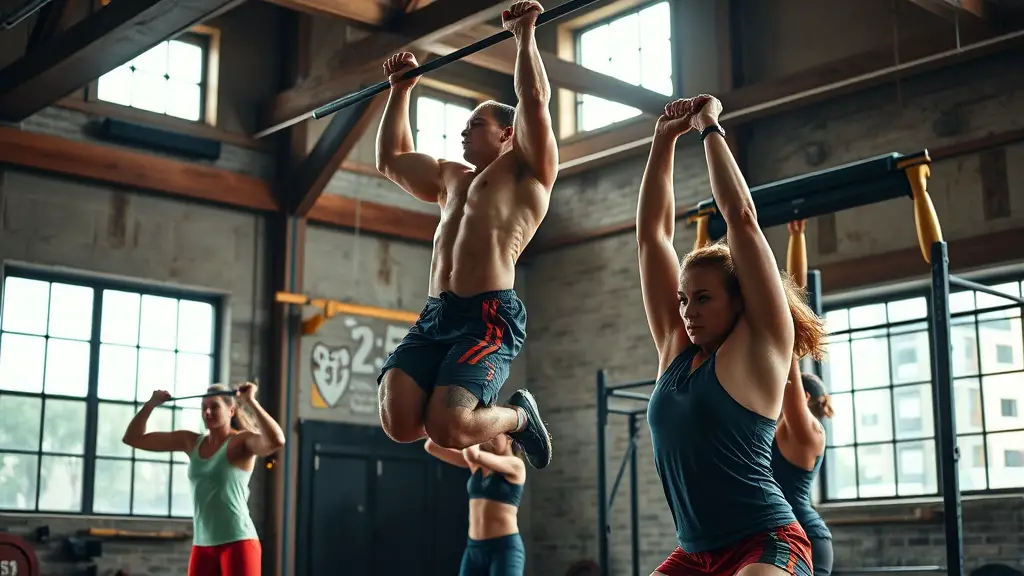How CrossFit Athletes Use Gym Training to Maximize Performance

CrossFit athletes maximize their performance by integrating specialized training techniques tailored to their unique needs. They focus on targeted strength sessions that build explosive power through Olympic lifts and plyometric drills. Mastering complex movements through skill work boosts efficiency, while conditioning drills enhance their endurance. Mobility exercises play a vital role in injury prevention. This holistic approach not only improves physical capabilities but also fosters mental resilience. Discover more about how these strategies elevate athletic performance.
Understanding the Importance of Specialized Training

While many athletes might think that general fitness routines are sufficient, understanding the importance of specialized training can greatly enhance performance in their specific sport. Specialized routines allow you to target the unique demands of your sport, honing skills that general workouts often overlook. For instance, if you’re a CrossFit athlete, implementing movements that mimic competition scenarios can improve your agility and strength, directly impacting your performance metrics.
Moreover, by focusing on specialized training, you can identify and address specific weaknesses that might hold you back. This targeted approach not only enhances your overall fitness but also maximizes your efficiency during competitions. Utilizing data from performance metrics, you can track progress and adjust your routines accordingly, ensuring you’re continually evolving as an athlete. Ultimately, embracing specialized training not only prepares you better but also instills a greater sense of purpose and motivation, pushing you closer to your goals. Additionally, it’s important to maintain a healthy relationship with exercise to prevent it from becoming an obsession that negatively impacts your life.
Targeted Strength Sessions for Increased Power
To achieve peak performance in CrossFit, incorporating targeted strength sessions into your training regimen is crucial, as these sessions not only build power but also enhance overall athletic capability. By focusing on targeted lifting and explosive movements, you’ll develop the strength necessary to tackle even the most challenging WODs.
Integrating exercises like pistol squat progressions can further enhance your lower body strength and stability, making you a more dynamic athlete on the field.
| Session Type | Focus Area |
|---|---|
| Olympic Lifts | Power Generation |
| Plyometric Drills | Explosive Strength |
| Squats | Lower Body Power |
| Deadlifts | Full Body Engagement |
Integrating these sessions into your routine will help you harness your full potential. Emphasizing compound lifts and explosive drills guarantees you’re not just lifting weights but also translating that strength into your performance. Remember, the goal isn’t just to lift heavier; it’s to become more powerful and dynamic in your movements, setting you up for success in every CrossFit challenge you face.
Skill Work: Mastering Complex Movements

Mastering complex movements is essential for any athlete looking to excel in CrossFit, as these skills not only enhance your performance but also improve your overall efficiency in workouts. Focusing on skill work allows you to refine your technique and develop ideal movement patterns, which can make a significant difference in competitive settings.
Here are four key components to reflect upon in your training:
- Consistent Practice: Regularly dedicate time to practice complex movements, ensuring you’re comfortable with the techniques.
- Video Analysis: Record your sessions to analyze your form and identify areas needing improvement.
- Coaching Feedback: Work with a knowledgeable coach who can provide insights on technique refinement and help you correct flaws.
- Progressive Overload: Gradually increase the intensity and complexity of your movements, challenging yourself to master new skills.
Enhancing Endurance Through Conditioning Drills
To boost your endurance, incorporating high-intensity interval training (HIIT) is essential; it maximizes your cardiovascular efficiency while pushing your limits. By integrating aerobic capacity improvement techniques, you’ll not only enhance your stamina but also sharpen your overall performance. Embracing these conditioning drills can transform your training, enabling you to excel in any athletic endeavor. Additionally, incorporating calorie burn strategies such as jump rope can significantly enhance your workout efficiency and contribute to weight loss.
High-Intensity Interval Training
Although many athletes focus on steady-state cardio to build endurance, incorporating High-Intensity Interval Training (HIIT) can greatly enhance your conditioning by pushing your body to adapt to varying intensities. The high intensity benefits of HIIT not only improve your aerobic capacity but also develop mental toughness. To maximize your performance, consider these interval strategies:
- Work-to-Rest Ratios: Experiment with different ratios, like 30 seconds of work followed by 15 seconds of rest, to find what challenges you.
- Varied Exercises: Use a mix of strength and cardio movements to target various muscle groups.
- Progressive Overload: Gradually increase the intensity or duration of your intervals to continue making gains.
- Consistency: Incorporate HIIT into your routine at least twice a week for best results.
Aerobic Capacity Improvement Techniques
Building on the benefits of High-Intensity Interval Training, enhancing your aerobic capacity is essential for improving overall endurance. To achieve this, focus on workouts that push your aerobic threshold, where your body efficiently utilizes oxygen. Incorporate longer steady-state runs or cycling sessions to develop a solid aerobic base, while also including tempo runs to elevate your VO2 max. Aim for intervals that challenge your heart rate, allowing you to recover quickly and maintain intensity. Mixing in conditioning drills like circuit training can stimulate both endurance and strength, ensuring a well-rounded approach. Remember, consistency is key; track your progress and gradually increase the duration and intensity of your sessions to maximize your aerobic capacity and performance in CrossFit.
The Role of Mobility Exercises in Injury Prevention

While many athletes focus on strength and endurance training, neglecting mobility exercises can greatly increase the risk of injury. Implementing effective mobility routines is essential for maintaining joint health and enhancing overall performance. Here are four key benefits of prioritizing mobility in your training:
- Enhanced Flexibility: Improved flexibility allows for better range of motion, reducing strain on muscles and joints.
- Injury Prevention: Regular mobility work helps identify and rectify movement deficiencies, minimizing the likelihood of injuries.
- Better Recovery: Mobility exercises aid in muscle recovery by increasing blood flow and reducing soreness.
- Improved Performance: Greater mobility translates to better movement efficiency, allowing you to perform exercises more effectively.
Cross-Training: Diversifying Your Fitness Routine
Cross-training is a powerful approach to enhance your overall fitness by incorporating various workout styles that prevent plateaus and reduce injury risk. By exploring popular methods like swimming, cycling, or yoga, you can build strength, improve endurance, and boost flexibility, keeping your routine fresh and engaging. Embracing this diversity not only optimizes your performance but also keeps you motivated on your fitness journey. For example, integrating low-impact alternatives like exercise bands can provide a full-body workout while being easy on your joints.
Benefits of Cross-Training
Engaging in a diverse fitness routine not only keeps your workouts fresh but also enhances your overall athletic performance. The cross training benefits are substantial, offering you a chance to improve in multiple areas. Here are four key advantages:
- Injury Prevention: By varying your exercises, you reduce the risk of overuse injuries common in repetitive training.
- Muscle Balance: Mixing disciplines helps strengthen underused muscle groups, leading to better overall strength.
- Increased Endurance: Incorporating different cardio activities can boost your stamina and resilience.
- Mental Engagement: A varied routine keeps boredom at bay, maintaining your motivation and commitment.
Popular Cross-Training Methods
When you’re looking to enhance your athletic performance, exploring different cross-training methods can be a game changer. Incorporating functional fitness routines into your regimen can boost overall strength and flexibility. Consider integrating strength cycling to build muscle endurance, while endurance plyometrics can develop explosive power. Speed drills will sharpen your quickness, and agility training can improve your responsiveness in competition. Don’t overlook the importance of core stability; it’s essential for maintaining balance and strength across all movements. Additionally, powerlifting techniques can elevate your strength foundation, while flexibility routines aid in recovery and prevent injuries. By diversifying your training, you’ll not only maximize performance but also keep your workouts engaging and effective.
Mental Preparation: Building Resilience and Focus

While physical strength and technique are essential in CrossFit, mental preparation often proves to be the unsung hero of athletic success. You can enhance your performance by cultivating mental toughness and resilience through various strategies. Here are four effective techniques to help you focus and stay strong:
- Visualization Techniques: Picture yourself successfully completing a workout or competition. This not only boosts confidence but also reinforces your body’s muscle memory.
- Mindfulness Practices: Incorporate meditation or deep breathing exercises to cultivate awareness and reduce anxiety during high-pressure moments.
- Positive Self-Talk: Replace negative thoughts with empowering affirmations. This shift can greatly impact your performance and outlook.
- Goal Setting: Break down your larger goals into smaller, achievable benchmarks. This keeps you motivated and focused on continuous improvement.
Embracing these methods can transform your mental game, making you an even stronger CrossFit athlete.
Frequently Asked Questions
How Often Do Crossfit Athletes Train Each Week?
CrossFit athletes typically train around five to six times a week, focusing on varied workouts that challenge their strength and endurance. This training frequency allows you to push your limits while incorporating essential recovery strategies to prevent burnout or injury. It’s important to listen to your body; if you’re feeling fatigued, don’t hesitate to take rest days. Balancing intense sessions with adequate recovery is key to maximizing your performance and achieving your fitness goals.
What Role Does Nutrition Play in Crossfit Training?
Nutrition’s essential in CrossFit training. You need to focus on macronutrient balance—carbs, proteins, and fats—to fuel your workouts and recovery. Meal timing also plays a significant role; eating the right nutrients before and after sessions can enhance your performance and muscle repair. By prioritizing these elements, you’re not just supporting your energy levels but also optimizing your gains. Remember, your body’s a machine, and the right fuel keeps it running efficiently!
How Do Athletes Track Their Progress in Crossfit?
Imagine you’re a CrossFit athlete aiming to improve your Fran time. You’d start by meticulously tracking your performance metrics, like your reps and times, using a journal or an app. This progress tracking helps you identify patterns and areas needing focus. You might notice you struggle with pull-ups, prompting targeted training. By regularly reviewing your data, you not only stay motivated but also guarantee your workouts align with your goals, maximizing your potential.
What Are Common Injuries in Crossfit and How to Prevent Them?
In CrossFit, common injuries often stem from improper form or overtraining. To prevent these injuries, you should focus on injury prevention techniques like proper warm-ups, mobility work, and strength training. Additionally, implementing effective recovery strategies, such as rest days and active recovery, can help your body heal and adapt. Stay mindful of your limits, listen to your body, and prioritize technique over intensity to guarantee a long, healthy training journey.
How Do Crossfit Athletes Handle Mental Fatigue During Training?
When you face mental fatigue during training, it’s essential to develop mental resilience. You can incorporate recovery strategies like mindfulness and visualization techniques to regain focus and motivation. Break your workouts into manageable segments, allowing yourself short mental breaks. Remember, pushing through isn’t always the answer; sometimes, stepping back helps you recharge. Emphasizing the mental aspect of your training can enhance your overall performance and keep you on track to achieve your goals.





